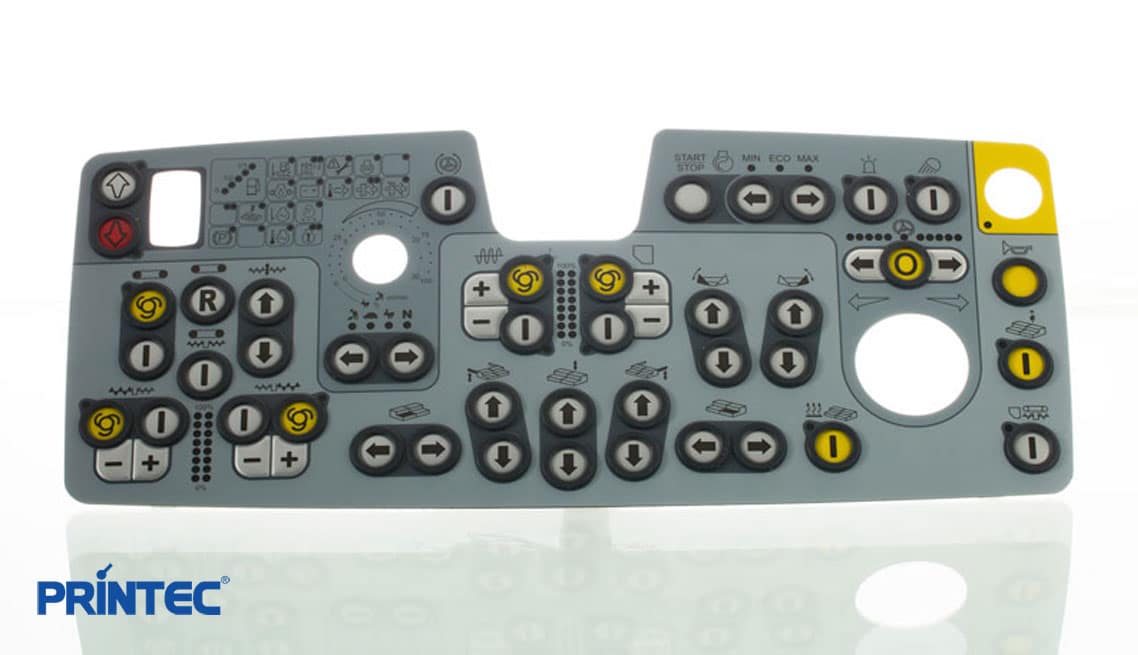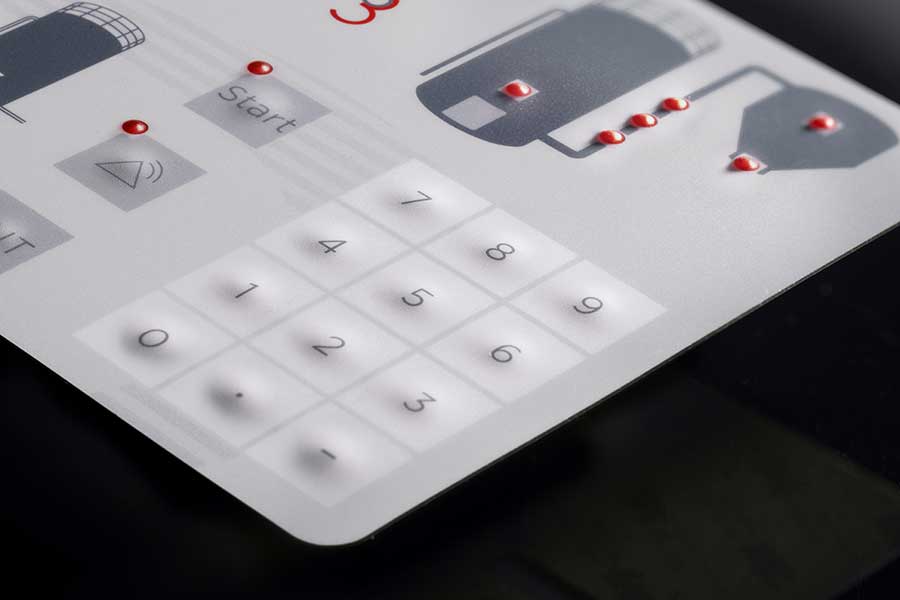A reliable membrane switch manufacturer provides both trial and mass production options.
Everything About Membrane Change: Comprehending Its Design and Performance
When you think concerning the control user interfaces in modern-day devices, membrane switches commonly come to mind. Let's explore what sets membrane layer switches apart from various other control systems.
What Are Membrane Buttons?

Their seamless nature makes them very easy to tidy and resistant to dirt and wetness, an essential attribute in several atmospheres. Membrane buttons can also be customized pertaining to shape, dimension, and graphics, permitting manufacturers to produce special user interfaces tailored to particular items. Plus, they're lightweight and thin, which helps in minimizing the overall bulk of gadgets. In general, membrane layer buttons play a significant duty in improving user experience throughout a broad array of applications.
How Membrane Layer Switches Job
When you press a secret on a membrane button, it activates a straightforward yet efficient device. membrane switch manufacturer. The leading layer, typically made of adaptable material, presses down onto a conductive layer underneath it.
You'll see that the tactile comments varies based upon the button layout, providing either a soft click or a more noticable reaction. As soon as you launch the key, the membrane layer returns to its initial setting, resuming the circuit and quiting the signal. This procedure happens nearly immediately, ensuring a receptive individual experience.
Membrane layer buttons are prominent as a result of their toughness and resistance to dust and moisture, making them suitable for different applications, from family home appliances to clinical tools. Understanding this procedure aids you value their widespread usage.
Key Parts of Membrane Layer Buttons
Recognizing the essential elements of membrane buttons is basic for realizing their performance and design. At the core, you'll discover the visuals overlay, which provides the visual interface for customers. Under that, there's a spacer layer that separates the circuit layers, ensuring that they don't make contact till pushed. The circuit layer is where the magic takes place; it consists of conductive traces that complete the circuit when you push the switch. Another crucial element is the sticky support, enabling the button to stick to surfaces securely. The safety layer shields versus ecological elements and wear, expanding the switch's life expectancy. Each part plays a considerable function in ensuring trustworthy performance and customer communication. By understanding these parts, you'll acquire understanding into how membrane layer switches run and their value in various applications.
Products Used in Membrane Layer Switch Over Design
The performance and resilience of membrane layer switches greatly depend upon the materials used in their layout. You typically encounter polyester and polycarbonate as primary substratums as a result of their outstanding toughness and flexibility. These materials resist scratches and chemicals, making them ideal for demanding environments.
The conductive layers typically make use of silver or carbon, chosen for their integrity and conductivity. membrane switch manufacturer. Silver supplies superior efficiency, while carbon is a cost-effective alternative. For the overlay, you may consider a matte or shiny finish, depending upon your visual needs and user experience
Adhesives play a necessary duty too; they bond layers firmly and guarantee longevity. Make sure to choose adhesives that stand up to ecological elements like temperature and moisture. Do not forget the significance of a great printing method for graphics, as it improves both performance and visual allure. Picking the best materials will ensure your membrane switch stands the test of time.
Design Considerations for Membrane Layer Buttons
While designing membrane layer switches, it's essential to think about different aspects that affect their performance and individual experience. Start by concentrating on the layout and button size; make sure they're instinctive and simple to navigate. Think about the tactile comments you wish to provide-- will customers need a noticeable click or a softer touch? Additionally, assume about the materials you'll make use of, as they'll influence longevity and visual appeals.
Verify your design suits environmental elements, like wetness or temperature variations, which might impact performance. By carefully considering these components, you'll create a membrane layer button that boosts usability and contentment.
Applications of Membrane Switches
Membrane layer buttons are versatile elements discovered in various applications, from commercial devices to customer electronic devices. You'll see their impact in equipments that call for sturdy interfaces and in tools that benefit from smooth designs. Recognizing these applications helps you value the functionality and practicality of membrane buttons in daily innovation.
Industrial Devices Use
When you're looking to improve the functionality of commercial devices, membrane buttons provide a trustworthy option that integrates sturdiness with straightforward design. These buttons are ideal for extreme atmospheres, providing resistance to dust, moisture, and chemicals. Embrace membrane layer buttons to streamline your operations and improve overall efficiency.
Customer Electronic Devices Integration
In the domain of customer electronic devices, membrane buttons play a vital duty in boosting user communication and device performance. You'll discover them in tools like microwaves, remote controls, and video gaming consoles, offering a seamless way to connect with innovation. Their sleek layout permits very easy integration right into various products, making controls user-friendly and straightforward. With their capacity to integrate graphics and backlighting, you can delight in a modern-day aesthetic that complements the device's general look. Membrane switches also guarantee longevity and resistance to dirt and wetness, expanding the life expectancy of your electronics. By picking membrane layer switches, you enhance not just the performance but also the style of your tools, making everyday communications smooth and satisfying.
Benefits and Negative Aspects of Membrane Layer Buttons
While membrane buttons provide an array of advantages, they also come with some disadvantages that you must consider. One substantial benefit is their compact design, try this making them perfect for space-constrained applications.

Membrane buttons can have a much shorter life-span contrasted to mechanical buttons, especially under hefty use. They can also be much less responsive, which might affect customer comments throughout operation. Stabilizing these pros and cons will aid you identify if membrane switches are the right fit for your job.
Frequently Asked Inquiries
The Length Of Time Do Membrane Layer Changes Normally Last?
Membrane layer switches typically last in between 5 to 10 years, relying on use and environmental conditions. You'll wish to examine factors like wear, direct exposure to moisture, and temperature variations to determine their long life effectively.
Can Membrane Switches Be Personalized for Details Designs?
Yes, you can tailor membrane buttons to fit particular designs (membrane switch manufacturer). You'll have the liberty to select shades, shapes, and designs that match your job's requirements, ensuring they mix effortlessly with your overall aesthetic
What Is the Price Range for Membrane Layer Change Manufacturing?
The expense variety for membrane layer button production usually drops between $1 and $10 each, relying on aspects like layout intricacy, quantity, and materials. You can obtain quotes from Get More Info producers to discover the very best alternative.

Are Membrane Layer Switches Waterproof or Immune?
Membrane layer buttons can be made to be water resistant or immune, depending upon materials used and building approaches. If you require them for damp environments, assure you specify those requirements during the layout process.
Exactly How Do Membrane Layer Changes Contrast to Standard Switches?
Membrane try this web-site layer switches are usually thinner and much more versatile than traditional buttons, providing a sleek style. They're often simpler to clean up and integrate, but might not offer the tactile feedback you're utilized to with mechanical options.
Conclusion
